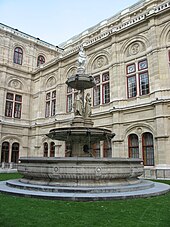Wöllersdorfer stone

The Wöllersdorfer Stein is a high quality limestone that was quarried in Wöllersdorf in the Vienna Basin .
use
Due to its hardness and resistance, it was used as building stone, similar to the Kaiserstein , and was mostly used as a load-bearing element or in the base area.
But since it was a cheaper stone than the Kaiserstein, it was also used in the period after the French wars at the beginning of the 19th century, mainly for the construction of the cellar walls of public buildings, while the walls above the ground level were built from the cheaper bricks.
Fountain in downtown Vienna
Some wells, the basin of which is made of Wöllersdorf limestone, document the prominent use of this rock. The two grave fountain in the Graben, the two wall decorative fountains at the Austrian Academy of Sciences , on the Franziskanerplatz the Well of Moses , the Andromeda fountain in the courtyard of the Old Town Hall and the Minerva fountain on the Stubenring .
State Opera

Materials that can be used to build the court opera :
“Wöllersdorfer Stein, is already in use, is an excellent hard material, only slightly unequal in texture for large quantities (- internal connection) and not very malleable for small details. So only needs to be used for plinths and free-standing, simply structured supports, which carry heavy loads and are exposed to heavy wear. "
In each of the two recessed corners of the opera's central elevation , a monumental fountain from 1868: the figures of Music and Loreley are made of Carrara marble , the three figures including the central basin and the main fountain itself are made of Wöllersdorf limestone.
literature
- Alois Kieslinger : The stones of the Vienna Ringstrasse , Franz Steiner Verlag GmbH. Wiesbaden 1972.
Web links
- August Hanisch, Heinrich Schmid: Austria's quarries. Directory of the quarries that deliver cuboids, steps, paving stones, grindstones and millstones or roof slabs. Graeser, Vienna 1901. (Online at ALO ).
Individual evidence
- ↑ Anton Pech, Michael Balak: Masonry drying: from the basics to practical application. Springer Verlag 2003. p. 52, ISBN 3-211-83805-8
- ↑ Stone exploration with Andreas Rohatsch from the TU-Ingenierurgeologie for the Steinmetzmuseum Kaisersteinbruch
- ↑ Administrative archive , city expansion fund Hofoper fasc. 107, November 5, 1863



